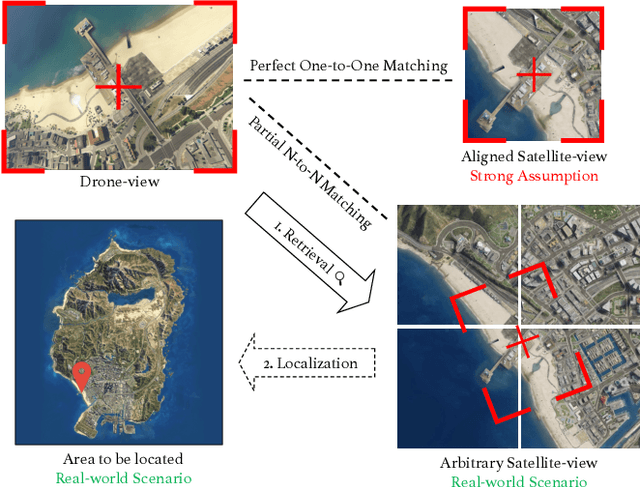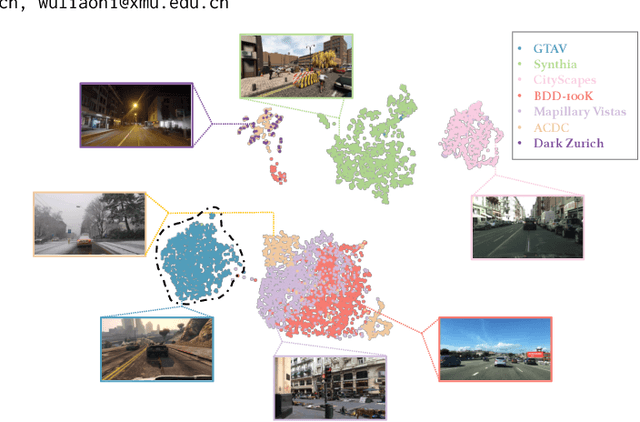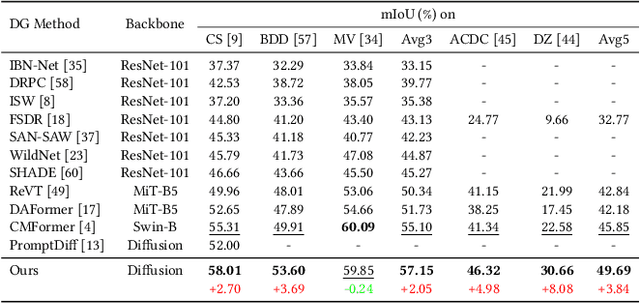Liaoni Wu
Generalized Diffusion Detector: Mining Robust Features from Diffusion Models for Domain-Generalized Detection
Mar 03, 2025Abstract:Domain generalization (DG) for object detection aims to enhance detectors' performance in unseen scenarios. This task remains challenging due to complex variations in real-world applications. Recently, diffusion models have demonstrated remarkable capabilities in diverse scene generation, which inspires us to explore their potential for improving DG tasks. Instead of generating images, our method extracts multi-step intermediate features during the diffusion process to obtain domain-invariant features for generalized detection. Furthermore, we propose an efficient knowledge transfer framework that enables detectors to inherit the generalization capabilities of diffusion models through feature and object-level alignment, without increasing inference time. We conduct extensive experiments on six challenging DG benchmarks. The results demonstrate that our method achieves substantial improvements of 14.0% mAP over existing DG approaches across different domains and corruption types. Notably, our method even outperforms most domain adaptation methods without accessing any target domain data. Moreover, the diffusion-guided detectors show consistent improvements of 15.9% mAP on average compared to the baseline. Our work aims to present an effective approach for domain-generalized detection and provide potential insights for robust visual recognition in real-world scenarios. The code is available at \href{https://github.com/heboyong/Generalized-Diffusion-Detector}{Generalized Diffusion Detector}
Game4Loc: A UAV Geo-Localization Benchmark from Game Data
Sep 25, 2024



Abstract:The vision-based geo-localization technology for UAV, serving as a secondary source of GPS information in addition to the global navigation satellite systems (GNSS), can still operate independently in the GPS-denied environment. Recent deep learning based methods attribute this as the task of image matching and retrieval. By retrieving drone-view images in geo-tagged satellite image database, approximate localization information can be obtained. However, due to high costs and privacy concerns, it is usually difficult to obtain large quantities of drone-view images from a continuous area. Existing drone-view datasets are mostly composed of small-scale aerial photography with a strong assumption that there exists a perfect one-to-one aligned reference image for any query, leaving a significant gap from the practical localization scenario. In this work, we construct a large-range contiguous area UAV geo-localization dataset named GTA-UAV, featuring multiple flight altitudes, attitudes, scenes, and targets using modern computer games. Based on this dataset, we introduce a more practical UAV geo-localization task including partial matches of cross-view paired data, and expand the image-level retrieval to the actual localization in terms of distance (meters). For the construction of drone-view and satellite-view pairs, we adopt a weight-based contrastive learning approach, which allows for effective learning while avoiding additional post-processing matching steps. Experiments demonstrate the effectiveness of our data and training method for UAV geo-localization, as well as the generalization capabilities to real-world scenarios.
Diffusion Features to Bridge Domain Gap for Semantic Segmentation
Jun 02, 2024



Abstract:Pre-trained diffusion models have demonstrated remarkable proficiency in synthesizing images across a wide range of scenarios with customizable prompts, indicating their effective capacity to capture universal features. Motivated by this, our study delves into the utilization of the implicit knowledge embedded within diffusion models to address challenges in cross-domain semantic segmentation. This paper investigates the approach that leverages the sampling and fusion techniques to harness the features of diffusion models efficiently. Contrary to the simplistic migration applications characterized by prior research, our finding reveals that the multi-step diffusion process inherent in the diffusion model manifests more robust semantic features. We propose DIffusion Feature Fusion (DIFF) as a backbone use for extracting and integrating effective semantic representations through the diffusion process. By leveraging the strength of text-to-image generation capability, we introduce a new training framework designed to implicitly learn posterior knowledge from it. Through rigorous evaluation in the contexts of domain generalization semantic segmentation, we establish that our methodology surpasses preceding approaches in mitigating discrepancies across distinct domains and attains the state-of-the-art (SOTA) benchmark. Within the synthetic-to-real (syn-to-real) context, our method significantly outperforms ResNet-based and transformer-based backbone methods, achieving an average improvement of $3.84\%$ mIoU across various datasets. The implementation code will be released soon.
 Add to Chrome
Add to Chrome Add to Firefox
Add to Firefox Add to Edge
Add to Edge